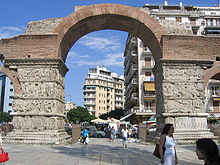Galerius Arch
The Arch of Galerius is a late Roman triumphal arch in Thessaloniki .
Temporal context
The Roman Emperor C. Galerius Valerius Maximianus was born around 250 AD as the son of a peasant family near Sofia (Serdica; Dacia Ripensis). He joined the military at an early age and soon made a name for himself because of his ability. Emperor Diocletian made him Caesar of the Eastern Roman Empire in the system of tetrarchy and married him in 293 to his daughter Valeria . When the Persians crossed the Tigris in 297 , Galerius challenged his opponents to battle without the prior consent of the emperor. This resulted in a defeat for the Romans, but the following year the Roman army invaded Armenia and defeated the Persian king Narses. For this, Galerius received permission to build a triumphal arch in Thessaloniki .
After Diocletian's resignation, Galerius succeeded him as Augustus and resided in Thessaloniki between 305 and 311 AD. Immediately after the victory, the construction of the rotunda began. Based on the images on the relief plates that adorn the arch, the completion before the year 305 AD can be assumed. Because on the plates Diocletian appears as the highest Augustus, which shows that the building was erected during his reign.
The Arc de Triomphe
The Galerius Arch is a tetrapylon , the basic structure of which originally consisted of four pillars. Barrel vaults rose above this, and the roof was provided by a dome. The main road, Via Egnatia , which connected Italy with the eastern provinces, ran through the long side of the arch . A mosaic hall or a sanctuary, with the rotunda in the center , was connected to the narrow sides . Today only two pillars remain from the building, the relief decorations of which are mostly very poorly preserved. The preserved remains measure 15 meters in height and 30 meters in width. Such colossal dimensions far surpass all other triumphal arches. Marble was used as building material, but large parts of the arch and the relief decoration are spolia .
The triumphal arch of Galerius serves as a source for the Persian campaign . The most important cornerstones of the events are to be captured briefly in scenic individual images.
The tables opposite each represent a pillar that has been preserved and provide an overview of the representations on the reliefs. The position of the plate on the pillar is indicated in Roman numerals, and the cardinal points are also given. The numbers 1 to 28 should indicate the correct cycle sequence.
The arrangement of the scenes is based on a chronological system. Starting with the lost pillar A ', the cycle continues in a clockwise direction, the images are to be read from top to bottom. Each pillar is dedicated to a main theme: A 'shows the glorification of the tetrarchs, B' the Median war , B the Armenian and A the Assyrian . A closer look at the respective frieze arrangement of the two pillars that have been preserved reveals fundamental similarities in the visual language. The reliefs on pillar A are mainly dedicated to the course of the war, while pillar B depicts the emperor's victory and triumph. This proves that the events on pillar B are the continuation of A.
The representations of the Persian War and the subsequent triumph were distributed on the inside of the pillars, which emphasized their importance. Imperial propaganda is skilfully disseminated on the memorial; the historical chronicle is of secondary importance. This can also be seen in the fact that images with the emperor at their center outnumber those of battle depictions. Victory and subsequent glorification of the ruler are clearly at the center of the statement conveyed by the bow. Thus, the Galerius Arch of Thessaloniki can be seen as a masterpiece of Roman triumphal iconography.
literature
- Ch. I. Makaronas: The arch of Galerius at Thessaloniki . Thessaloniki 1970.
- Margret S. Pond: The arch of Galerius. A sculptural record of the age of the Tetrarchies . Ann Arbor 1970.
- Hans Peter Laubscher : The relief decoration of the Galerius arch in Thessaloniki . Berlin 1975.
- Margret S. Pond Rothman: The thematic organization of the panel reliefs on the arch of Galerius . In: American Journal of Archeology . No. 81, 1977, pp. 427-454.
- Josef Engemann : Direction of acclamation, direction of victory and defeat on the Galerius Arch in Saloniki. On the occasion of the new book by HP Laubscher . In: Yearbook for Antiquity and Christianity . No. 22, 1979, 150-160.
- Georgos Velenis: Architectural Problems of the Galerius Arch in Thessaloniki . In: Archäologischer Anzeiger . 1979, pp. 249-263.
- Georgos Velenis: Subsequent observations on the superstructure of the Galerius Arch in Thessaloniki . In: Archäologischer Anzeiger . 1983, pp. 273-275.
- Wulf Raeck : Tu fortiter, illegal sapienter. Augusti and Caesares in the relief decoration of the Galerius Arch of Thessaloniki . In: Hans-Ulrich Cain (Ed.): Contributions to iconography and hermeneutics. Festschrift for Nikolaus Himmelmann . von Zabern, Mainz 1989, pp. 453-457.
- Manfred Clauss (ed.): The Roman emperors. 55 historical portraits from Caesar to Justinian . Munich 2001, pp. 276–282.
- Emanuel Mayer: Rome is where the emperor is. Investigations into the state monuments of the decentralized empire from Diocletian to Theodosius II . Mainz 2002.
Web links
Coordinates: 40 ° 38 ′ 0 ″ N , 22 ° 57 ′ 10.6 ″ E

